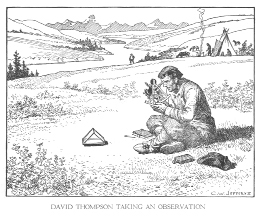Module 7
1. Module 7
1.22. Page 5
Module 7: Trigonometry
Lesson Summary

Jefferys, C. W. The Picture Gallery of Canadian History vol 2.
Toronto: Ryerson Press, 1942. p 146
David Thompson (1770–1857) was a man who had many jobs associated with the fur trade—explorer, surveyor, and map maker. Thompson showed he was good at mathematics from an early age. He studied trigonometry, algebra, geography, and astronomy. At the age of 14, David Thompson joined the Hudson’s Bay Company in Canada after leaving his home in England.
Over his lifetime, David Thompson mapped almost 4 million square kilometres of land that was later to become part of Canada and the United States. He is considered one of the best surveyors who ever lived! Do you see what a little trigonometry can do?
In this lesson you explored this question:
-
How is the sine ratio used to solve a variety of practical problems?
Check your level of understanding of the materials covered in this lesson by completing “Lesson 4 Traffic Lights.” If you select an amber or red traffic light in the multimedia piece, you will receive information about additional work you can complete to improve your understanding of the topics. Complete the suggested work before you proceed to the Lesson 4 Assignment. If you experience difficulty, contact your teacher before starting the Lesson 4 Assignment.
To answer this question, you reviewed the definition of the sine function as the ratio of the side opposite to the hypotenuse for a given acute angle in a right triangle. You used this ratio to find missing sides and missing angles in a variety of practical problems.
 Assignment
Assignment
Retrieve the Lesson 4 Assignment Booklet you saved in your course folder at the start of this lesson. Complete the Assignment.
Resave your Assignment Booklet in your course folder and submit a copy to your teacher for assessment.
Unit 3 Project
Before you move on to Lesson 5, you should take a look at your Unit 3 Project topic. Look for right triangles and places where the sine ratio could help you find a length measurement or angle measurement. Make sure you keep any sketches and calculations in your course folder for use in your presentation. For more information about this step, and later steps, refer to the Unit 3 Project.